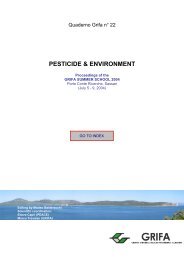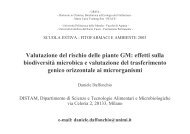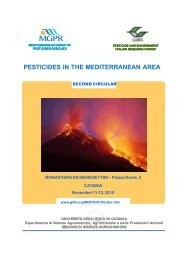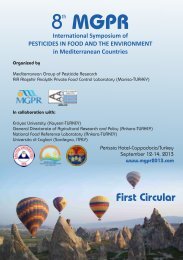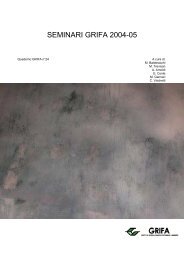International Congress BIOLOGICAL PRODUCTS - Gruppo di ...
International Congress BIOLOGICAL PRODUCTS - Gruppo di ...
International Congress BIOLOGICAL PRODUCTS - Gruppo di ...
Create successful ePaper yourself
Turn your PDF publications into a flip-book with our unique Google optimized e-Paper software.
28<br />
PHOTORHABDUS AND XENORHABDUS: A NEW SOURCE OF USEFUL COMPOUNDS FOR<br />
<strong>BIOLOGICAL</strong> CONTROL<br />
A. Ragni and F. Valentini<br />
BioTecnologie BT srl Pantalla <strong>di</strong> To<strong>di</strong> 06050 Perugia Italy<br />
Tel: ++39 – 075 - 895091 Fax: ++39 – 075 – 888 776 E-mail: aragni.bt@parco3a.org<br />
IntroductionThe genera Photorhabdus and Xenorhabdus are symbiotic Enterobacteriaceae bacteria<br />
associated with entomopathogenic nematodes of the genera Heterorhab<strong>di</strong>tis and Steinernema, respectively. The<br />
characteristics of both Photorhabdus and Xenorhabdus genera have been reviewed by Forst & Nealson (1996),<br />
and by Forst et al. (1997).<br />
Recently Bowen et al. (1998a; 1998b) and Blackburn et al. (1998) <strong>di</strong>scovered and characterized an insecticidal<br />
toxin complex that it is secreted into the culture me<strong>di</strong>um by Photorhabdus luminescens strain W-14. Except for<br />
this specific strain, the insecticidal capability of entomopathogenic soil nematode symbiotic bacteria has been<br />
reported only when carried into the insect by the nematodes or artificially injected into their haemocel.<br />
This work reports the isolation of a unique strain Photorhabdus sp., named XP01, selected among 12<br />
Photorhabdus and Xenorhabdus isolates, that <strong>di</strong>splays an insecticidal activity when fed to the neonate larvae of<br />
several Lepidoptera pests.Materials and Methods.<br />
Bacteria isolation<br />
The bacteria strains tested were isolated as described by Akhurst (1980), from cadavers of Galleria mellonella<br />
infected with Heterorhab<strong>di</strong>tis spp. or with Steinernema spp. strains belonging to the collection of<br />
entomopathogenic nematodes held at BioTecnologie S.r.l (BT) laboratories. A list of the isolated strains is<br />
shown on Table 1. Cultures were maintained by weekly subculturing on Nutrient Agar plates and incubated in<br />
the dark at 25°C. Inocula for liquid cultures were prepared as fermented broth aliquots containing glycerol at a<br />
final concentration of 15% (v/v) and stored at -80°C.<br />
Bacterial preparations<br />
Whole cultures were obtained by growing the strains in a Casein peptone plus yeast extract liquid me<strong>di</strong>um in the<br />
dark at 25°C and shaking at 180 rpm , for a period of either 19 or 24 hours. Technical powder of XP01 was<br />
prepared by freeze-drying the pellet obtained by centrifugation the bacterial culture at 6,238 x g for 40 min. The<br />
pellet was washed three times in a neutral Ringer’s solution prior freezing. Freeze-drying resulted in cells dead<br />
since plating the resuspended technical powder gave no colony growing on Nutrient Agar.<br />
Insects rearing and bioassay techniques<br />
Colonies of Mamestra brassicae, Cy<strong>di</strong>a molesta, Spodoptera littoralis, Helicoverpa armigera, Scotia segetum<br />
and Agrotis ipsilon are continuously reared at BT insectarium under controlled environmental con<strong>di</strong>tions and fed<br />
with semi-synthetic <strong>di</strong>ets.<br />
Insecticidal activity of bacterial suspensions was measured by using an overlay technique bioassay. Bacterial<br />
preparations at <strong>di</strong>fferent serial <strong>di</strong>lutions were applied in 50 µl aliquots in the wells of a <strong>di</strong>et bioassay trays<br />
(surface area 175 mm 2 ) containing 1 g of an insect meri<strong>di</strong>c <strong>di</strong>et. As control, the insect <strong>di</strong>et was treated with<br />
deionized sterile water. After drying, one unfed 1st instar larva (neonate) was placed in each well. Each<br />
treatment was applied to 32 insects. Mortality was scored after 5 days of incubation at 27°C.<br />
Results.<br />
Preliminary Screenings<br />
A total of 12 Photorhabdus and Xenorhabdus bacterial isolates were assayed for insecticidal activity against<br />
neonates of Mamestra brassicae and of Cy<strong>di</strong>a molesta in a surface contamination assay. As shown in Figure 2,<br />
neonates of Cy<strong>di</strong>a molesta were more susceptible than those of Mamestra brassicae when exposed to fermented<br />
broths of Photorhabdus and Xenorhabdus isolates. Treatments with XP01 and XP04 fermented broths resulted in<br />
100 % mortality of C. molesta neonates. In this species the mortality rate ranged from 25 to 41% for treatments<br />
with XP136, XP1007 and XP127. Low activity (from 0% to 19% mortality) against C. molesta neonates was<br />
recorded when treatments were done with the remaining bacterial strains. A 100% mortality of Mamestra<br />
brassicae neonates was observed when the insects were treated with XP01. A lower mortality equal to 74% was<br />
observed when XP04 was used. A residual activity (5% larval mortality) was recorded when treatment was done<br />
with strain XP10.<br />
PDF creato con FinePrint pdfFactory versione <strong>di</strong>mostrativa http://www.secom.re.it/fineprint<br />
132



